Lockdown reduced children’s contacts with GPs but increased remote appointments

Young people’s contacts with GPs in England dropped by 41% overall during the first COVID-19 lockdown in 2020 compared with previous years.
These are the findings of a study, led by researchers from Imperial College London, using health record data from more than four million patients in England.
The researchers found a significant drop in how often children and young people (aged 0 to 24 years) saw their general practitioner (GP) following the introduction of stay-at-home guidance in 2020.
The findings, published in the British Journal of General Practice, show that while face-to-face appointments fell by 88% compared to before the pandemic, this drop was mitigated by a more than two-fold increase in telephone, video and online contacts with GPs over the lockdown, meaning the overall drop in appointments was 41%.
"Moving forward, more research is needed to determine the optimal combination between face-to-face and remote contacts." Dr Kim Foley School of Public Health
According to the authors, contacts for non-transmissible conditions that could require hospital admission if not treated (such as urinary tract infections or epilepsy) remained relatively high and there is little evidence of a rise in serious illness in children from delaying visiting the GP.
The researchers say that as primary care adapts to a post-pandemic model, their analysis could offer some insights into the best balance between remote and face-to-face appointments for children and young people.
Dr Kim Foley, first author of the study who is based in the Child Health Unit within Imperial’s School of Public Health, said: “We know the national lockdowns disrupted all aspects of life, including how people accessed their GP services.
“Our study shows a huge shift to remote contacts during the first COVID-19 lockdown that mitigated the overall falls in children’s contacts with a GP. Moving forward, more research is needed to determine the optimal combination between face-to-face and remote contacts, and it is important to consider the preferences of children and families.”
Before this study, the specific impact of the COVID-19 pandemic response on children and young people’s access to primary care was largely unknown.
Researchers used data from GP practices in England from 2015 to 2020, which included more than 47 million electronic health records covering over four million children and young people.
Sharp drop in respiratory illness contacts
In addition to the overall drop in children and young people’s contact with GPs, the study also found that the total number of contacts with GPs for respiratory illnesses in children and young people fell by 74%. This drop may be explained by fewer social contacts during the first lockdown leading to less cases of infectious illness.
Children aged 1-14 years also saw greater falls in overall contacts with GPs compared with infants (0 to 12 months) and young people aged 15-24 years.
"It is reassuring to see that the efforts of hard-working GPs across the country helped children to see their GP safely across the first lockdown period." Professor Sonia Saxena School of Public Health
The fall in contacts for non-transmissible conditions (31%) was less than the fall seen overall (41%), suggesting that GPs largely continued to provide accessible acute care for children and young people during the lockdown.
Professor Sonia Saxena, a practising GP and senior author for the study, who leads the Child Health Unit within the School of Public Health at Imperial College London, said: “It is reassuring to see that the efforts of hard-working GPs across the country helped children to see their GP safely across the first lockdown period while observing the government safety advice not to attend in person.
“Our study shows lockdown measures resulted in fewer contacts for respiratory illnesses but with a lift in restrictions, infections are again on the rise and families need our support to keep children healthy in the community.
“Our GP practices need much more investment in staff and resources to cope with the added workload that we were already struggling with even before the pandemic.”
The research was commissioned by the National Institute for Health Research (NIHR) under the Applied Health Research (ARC) programme for Northwest London and supported by the NIHR Policy Research Programme COVID-19 research.
-
‘Impact of covid-19 on primary care contacts with children and young people aged 0-24 years in England; longitudinal trends study 2015-2020' by Kimberley A Foley et al is published in British Journal of General Practice.
Main article image: Shutterstock.
Article supporters
Article text (excluding photos or graphics) © Imperial College London.
Photos and graphics subject to third party copyright used with permission or © Imperial College London.
Reporter
Conrad Duncan
Communications Division